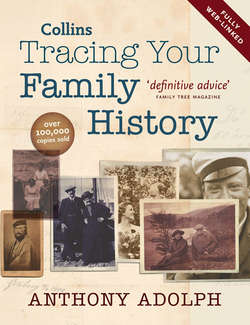Читать книгу Collins Tracing Your Family History - Ryan Tubridy, Anthony Adolph - Страница 128
OVERCOMING PROBLEMS
ОглавлениеIn many cases, your research will not go smoothly and you will not be able to find the right people straight away. A chief reason for this is that the indexes are full of mistakes, made by the indexers either through carelessness, or failure to understand the records (some of the 1901 census returns were indexed by prisoners), or because the handwriting in the originals can be very hard to read. So, if you think you know where the family lived but cannot find them using the indexes, search the originals (see here). The other main problem with using the indexes is that your ancestors were not recorded originally in the way you would expect. You might expect your ancestor to appear as ‘James Dinnie’ age 24, born in Kirkintilloch, but he might actually have been recorded as Jim Dinny, 23, born in neighbouring Lenzie. You may therefore need to try and second-guess how someone might have been misrecorded at the time, before successfully finding them in the indexes. If you do find someone whose details are slightly different to what you expected, as in the foregoing example, you will of course need to make sure the other co-ordinates match up and that you have found the right person. You can see, for example, if the father’s name matches that given on James’s marriage certificate.
Almost all records used in family history are likely to be inaccurate, but censuses are amongst the worst. This is because if you ask people fairly intrusive questions, they are likely to be rather evasive in their answers. People were, and continue to be, highly suspicious of the Government’s reasons for wanting to know about them. In the 19th century, many poorer people were (not always unjustly) afraid that, if they owned up to having come from somewhere else, they would be ordered to return thence. Therefore, the most common answer enumerators received to the question ‘where were you born?’, was therefore a blunt ‘here!’.
Places of birth could be wrong for other reasons too. Someone who was born in Oxford but grew up from an early age in Cambridge might very well think that the latter was their birth place. People also tended to generalise. If someone was born in the tiny village of Sturry near Canterbury and then moved away, they would probably tell everyone they were from Canterbury, and this is what might then be recorded on a census form (and hence in the census indexes).
Information about the family was usually supplied by only one person, but not necessarily the head of the household. A child might supply information about their parents and siblings, and there are cases when the task seems to have been delegated to servants or even the lodger: no wonder details were sometimes inaccurate. Ages could also be wrong when people did not want to admit to being as old or as young as they really were. In 1876 it became compulsory for children under 13 to go to school. However, many hard-up parents still sent their children out to work and lied to the enumerators, saying their children were ‘scholars’, the standard term for a child at school, when they were in fact out at work every day and receiving no education at all.
Greater inaccuracies arose when institutions were enumerated. In some cases, prison governors simply noted down the inmates’ initials.
Relationships to the head of the household were sometimes given inaccurately or falsely. The illegitimate son of the head of the household’s daughter might end up being enumerated as the head’s youngest son, for instance.
Addresses can cause problems, not least because streets could be renamed. House numbering was virtually unknown in rural areas and, when used in towns, it would change as extra houses were built in streets. Therefore, if your ancestors are not at the house number you expected, check the rest of the street, and if they are not there look around the area or examine maps and contemporary street directories (see Chapter Eight) for guidance. Related problems arise when houses had doors on two different streets, thus giving the house two potential addresses. This is another area in which studying a map can suggest different solutions to the problem of not finding your ancestors where you expected them to be.
When using the censuses to ascertain where someone was born before 1837, bear in mind that their place of birth might not be the same as their place of baptism. Wives often went home to their mothers to give birth to their first child, but the child’s baptism would usually be in the wife’s new parish of residence.
The general, catch-all solution to remaining problems surrounding the use of the censuses is to use earlier or later censuses, General Registration records, or other records described later in this book, to gain further co-ordinates about the family.
